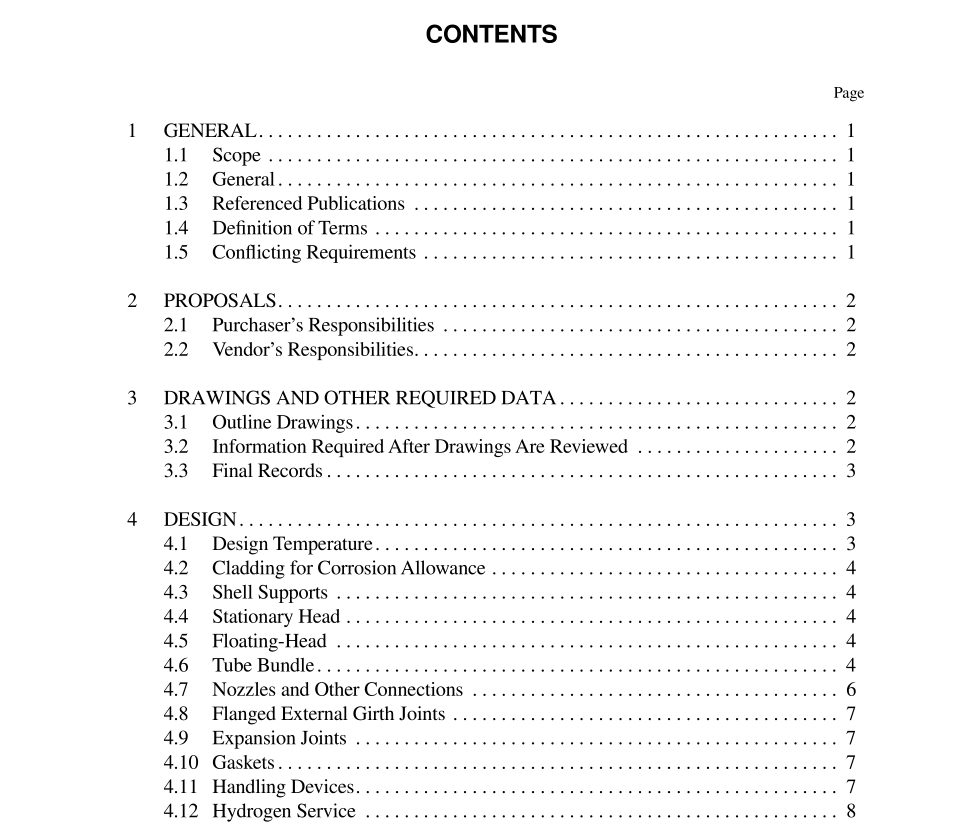API STD 660 pdf download

API STD 660 pdf download.Shell–and–Tube Heat Exchangers for General Refinery Services
1.1 SCOPE
1.1.1 This standard defines the minimum requirements for the mechanical design, material selection, fabrication, inspec- tion, testing, and preparation for shipment of shell-and-tube heat exchangers for general refinery services. 1.1.2 As used in this standard, the term heat exchangers includes heaters, condensers, coolers, and reboilers. 1.2 GENERAL Note: A bullet ( • ) in the margin indicates that a decision by the pur- chaser is required. Decisions should be indicated on the Shell-and- Tube Heat Exchanger Checklist (see Appendix A) 1.2.1 Heat exchangers shall conform to the latest edition of the Standards of the Tubular Exchanger Manufacturers Asso- ciation 1 (TEMA Standards) and to the additional require- ments of this standard. Compliance with the latest edition of the ASME 2 Boiler and Pressure Vessel Code, Section VIII, Division 1 , is mandatory. 1.2.2 Heat exchanger construction shall conform to TEMA Standards, Class R. 1.2.3 The vendor shall comply with local rules and regula- tions that are specified by the purchaser. 1.2.4 If specified by the purchaser or required by state or local codes, the vendor shall register each heat exchanger with the National Board of Boiler and Pressure Vessel Inspectors.
1.4 DEFINITION OF TERMS
Terms used in this standard are defined as follows: a. A heat exchanger unit consists of one or more heat exchangers for a specified service that may include alterna- tive operating conditions. b. The item number is the purchaser’s identification number. c. The effective surface is the outside surface area of the tubes, excluding the portion in each tubesheet. d. A tube-to-tubesheet strength weld is one in which the design strength is equal to or greater than the maximum allowable axial tube strength. Such tube-to-tubesheet joints are welded with filler metal and the depth of any groove, if used, plus fillet weld shall not be less than 1.4 times the nom- inal wall thickness of the tubes. e. A tube-to-tubesheet seal weld is one used to supplement an expanded tube joint to ensure leak tightness. Such tube-to- tubesheet joints may be welded with, or without, filler metal.
2.1 PURCHASER’S RESPONSIBILITIES
The purchaser’s inquiry shall include the specification sheet or sheets, a checklist, if required, and other applicable information outlined in this standard (see Appendices A, B, and C). All necessary data for the design of a heat exchanger unit, including any special requirements or exceptions to this standard, shall be provided. 2.2 VENDOR’S RESPONSIBILITIES 2.2.1 The vendor’s proposal shall include, for each unit, a completed specification sheet (see Appendix C) or, when a specification sheet is included in the inquiry, a statement indi- cating complete compliance with that specification sheet. 2.2.2 Designs that are not fully defined by the nomencla- ture in TEMA Standards, Section 1 shall be accompanied by sketches that are sufficient to describe the details of construction. 2.2.3 Where distributor belts are provided, the vendor shall define the type of construction proposed. 2.2.4 The Vendor shall determine the need for, and if required, include expansion joints based on all conditions supplied by the purchaser. The Vendor shall state the type of construction proposed. 2.2.5 The proposal shall include a detailed description of all exceptions to the requirements of the purchaser’s inquiry. 2.2.6 Unless otherwise specified, the vendor shall supply the complete heat exchanger unit including: a. Bolts, nuts and gaskets for the interconnecting nozzles of directly flanged stacked heat exchangers. b. Shims and bolting for interconnecting supports of heat exchangers. 2.2.7 Unless otherwise specified, the vendor shall provide quotation for the following separately for the purchaser’s consideration. a. Test component consisting of a test ring and gland, TEMA Standards, Figure E-4.13-2 or equivalent, for each heat exchanger or group of similar heat exchangers with floating heads. b. One spare set of gaskets per heat exchanger unit.









